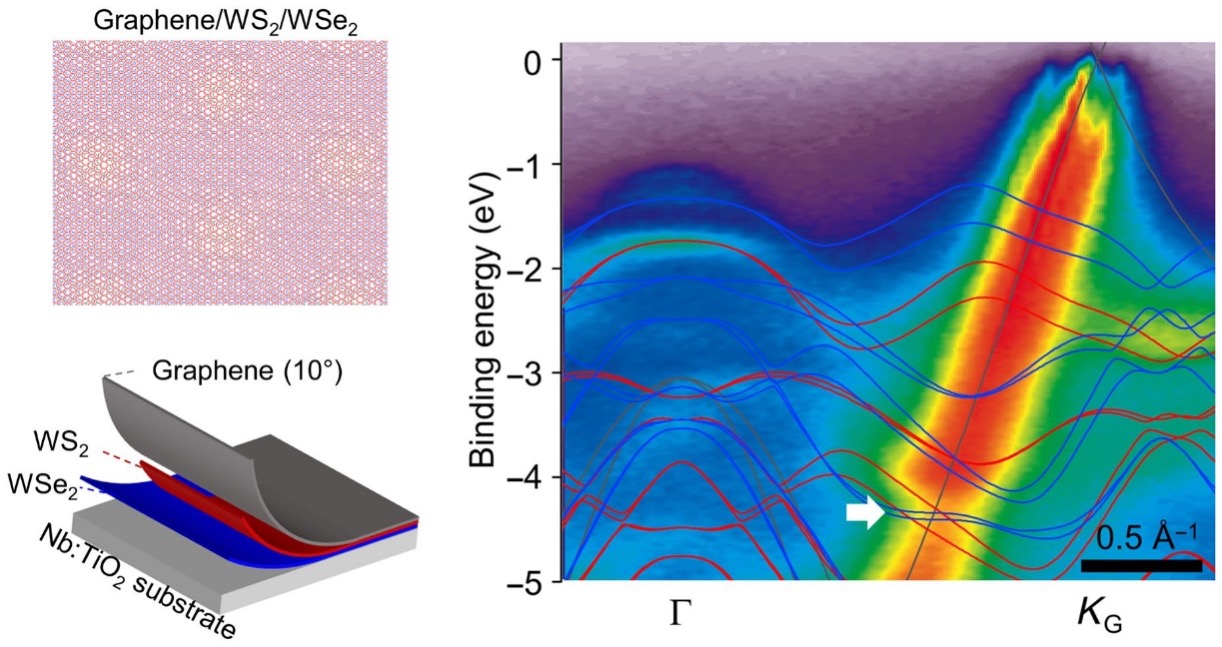PARADIM Highlight #62—In-House Research (2022)
Kyle M. Shen, Eun-Ah Kim & Jie Shan (PARADIM), Kin Fai Mak (Cornell), Eli Rotenberg & Aaron Bostwick (Advanced Light Source)
Quantum fabrics are artificially created materials that offer novel electronic, magnetic, or topological functionalities that do not exist in bulk and could play an important role in future quantum technologies. One method to make them is the assembly of layered two-dimensional van der Waals materials. The stacked layers exhibit moiré superlattices that are tunable by the assembly process allowing arbitrary periodicities to be achieved by rotating the alignment between the layers. This approach provides a versatile platform for engineering and investigating new quantum states of matter.

Figure: (left) Depiction of the atomic arrangement of an aligned WS2/WSe2 moiré superlattice with a graphene layer. Schematics of the assembly of a moiré superlattice sample on a Nb:TiO2 substrate, where WS2, WSe2, and graphene are represented by red, blue, and gray colors, respectively. (right) ARPES spectra with overlaid density functional theory (DFT) calculations of the band structures for individual monolayer graphene (gray), WS2 (red), and WSe2 (blue). The white arrow indicates hybridization between the graphene and transition metal dichalcogenide bands.
Quantum fabrics are artificially created materials that offer novel electronic, magnetic, or topological functionalities that do not exist in bulk and could play an important role in future quantum technologies. One method to make them is the assembly of layered two-dimensional van der Waals materials. The stacked layers exhibit moiré superlattices that are tunable by the assembly process allowing arbitrary periodicities to be achieved by rotating the alignment between the layers. This approach provides a versatile platform for engineering and investigating new quantum states of matter.
Here, members of PARADIM’s in-house research team combine transition metal dichalcogenides sheets and graphene into bilayer and trilayer stacks. Combining angle-resolved photoelectron spectroscopy (ARPES) and advanced theoretical calculations the team investigated moiré superlattices over a wide range of energies and momenta commonly accessible by optical or transport probes.
The experiments reveal microscopic structures of moiré superlattices and that moiré superlattice effects are richer than previously known, motivating a new understanding of the mechanism by which these moiré potentials are formed. In addition, the work shows that the capping graphene layer can be imprinted with strong potentials of controllable wavelengths from the underlying moiré superlattice.
Moiré superlattices constructed from transition metal dichalcogenides have demonstrated a series of emergent phenomena, including moiré excitons, flat bands, and correlated insulating states. All of these phenomena depend crucially on the presence of strong moiré potentials, yet the properties of these moiré potentials, and the mechanisms by which they can be generated, remain largely open questions. Here, we use angle-resolved photoemission spectroscopy with submicron spatial resolution to investigate an aligned WS2/WSe2 moiré superlattice and graphene/WS2/WSe2 trilayer heterostructure. Our experiments reveal that the hybridization between moiré bands in WS2/WSe2 exhibits an unusually large momentum dependence, with the splitting between moiré bands at the Γ point more than an order of magnitude larger than that at K point. In addition, we discover that the same WS2/WSe2 superlattice can imprint an unexpectedly large moiré potential on a third, separate layer of graphene (g/WS2/WSe2), suggesting new avenues for engineering two-dimensional moiré superlattices.
This advance points to a new approach in engineering designer quantum fabrics with arbitrary periodicities, through the coupling of a third layer to an existing moiré heterostructure.
This advance was achieved only through the close combination of state-of-the-art fabrication of 2D heterostructures, advanced nano-ARPES experiments, and theoretical support, brought together in a closed-loop fashion through the MIP.
This work was initiated by members of the PARADIM in-house research team and included collaborators from Cornell University and the Advanced Light Source at Lawrence Berkeley National Laboratory.
S. Xie, B.D. Faeth, Y. Tang, L. Li, E. Gerber, C.T. Parzyck, D. Chowdhury, Y.-H. Zhang, C. Jozwiak, A. Bostwick, E. Rotenberg, E.-A. Kim, J. Shan, K.F. Mak, and K.M. Shen, “Strong Interlayer Interactions in Bilayer and Trilayer Moiré Superlattices” Sci. Adv. 8, abk1911 (2022).
This work was supported by the National Science Foundation [Platform for the Accelerated Realization, Analysis, and Discovery of Interface Materials (PARADIM)] under cooperative agreement number DMR-2039380 and DMR-2104427 and by the Air Force Office of Scientific Research grant number FA9550-21-1-0168. This research used resources of the Advanced Light Source, which is a DOE Office of Science User Facility under contract no. DE-AC02-05CH11231. S.X. acknowledges support from a Kavli Postdoctoral Fellowship. B.D.F. acknowledges support from the NSF Graduate Research Fellowship under grant number DGE-1650441. This work made use of the Cornell Center for Materials Research Shared Facilities, which are supported through the NSF MRSEC program (DMR-1719875).







